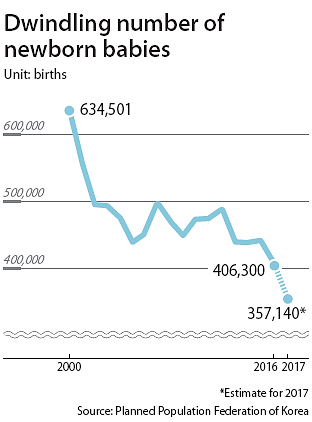Number of newborns plummets

According to the federation, a non-governmental organization, 110,710 babies received newborn screening tests from January to March this year. The number is 15,287 lower than 125,997 of the same period last year, showing a 12.1 percent drop.
The newborn screening tests are free-of-charge physical examinations given at all obstetrics hospitals within one week of birth. Blood samples are taken and nine medical organizations run tests. The Planned Population Federation of Korea collects the outcomes and manages the database.
“Because 100 percent of the newborn babies are given the tests since 2015, the number of babies who underwent the tests is practically the same as the number of newborns,” said Park Sang-geun, head of the Population and Health Division of the Planned Population Federation of Korea. Another statistic by the government also confirms a shocking drop in the number of newborns. Statistics Korea announced in January that the number of newborns that month was down by 11.1 percent compared to the same period last year.
“The newborn screening tests is an indicator,” said an official of the Ministry of Health and Welfare, who spoke on the condition of anonymity. “If the trend of the first quarter continues till the end of this year, the number of newborns for this year will drop to the level of 360,000.”
Using the rate of decrease for the first quarter, Korea is expected to have 357,140 newborns this year. Last year, 406,300 babies were born.
The ministry’s statistics also showed that 102,668 applications were filed for the delivery-expenses subsidy and maternity care program from January to March, 7.9 percent down from that of the same period last year.
The low birthrate is one of Korea’s most urgent challenges. In 1996, the number of newborns went down to 600,000 level. It broke the 500,000 mark in 2001 and the 400,000 mark in 2002. If the current trend continues, this year will set a new record low by entering the 300,000 level.
Although the government spent 102 trillion won ($90.5 billion) from 2006 to 2016, the birth rate is falling even more rapidly.
Other signs are also bad. The youth unemployment recorded the worst-ever 9.8 percent last year, and the number of marriages is also low. Last year, 281,635 marriages were registered, indicating that this year’s number of newborns will likely be low.
Ahead of the May 9 presidential election, candidates promised childcare subsidies, larger amount of current subsidies for home care, better maternity leave program, increases of state-run day care centers and cash incentives for having a second child. Pledges, however, did not come with solid funding plans and their feasibility is questionable.
“The extremely low birth can never be resolved with childcare policies,” said Kim Sang-ho, head of the Korea Institute for Health and Social Affairs. “Housing, education and employment policies must work comprehensively to see some effects.”
He added, “Japanese Prime Minister Shinzo Abe appointed the so-called ‘100 million minister’ in order to fight the population issues. The next president must also have a strong grip on the issue and show leadership to overcome this challenge.”
Abe unveiled a plan last year to prevent the country’s population of 127 million from sliding below 100 million. Katsunobu Kato was appointed to a new minister position in the cabinet to push the program forward.
BY SHIN SUNG-SIK, SER MYO-JA [ser.myoja@joongang.co.kr]










with the Korea JoongAng Daily
To write comments, please log in to one of the accounts.
Standards Board Policy (0/250자)